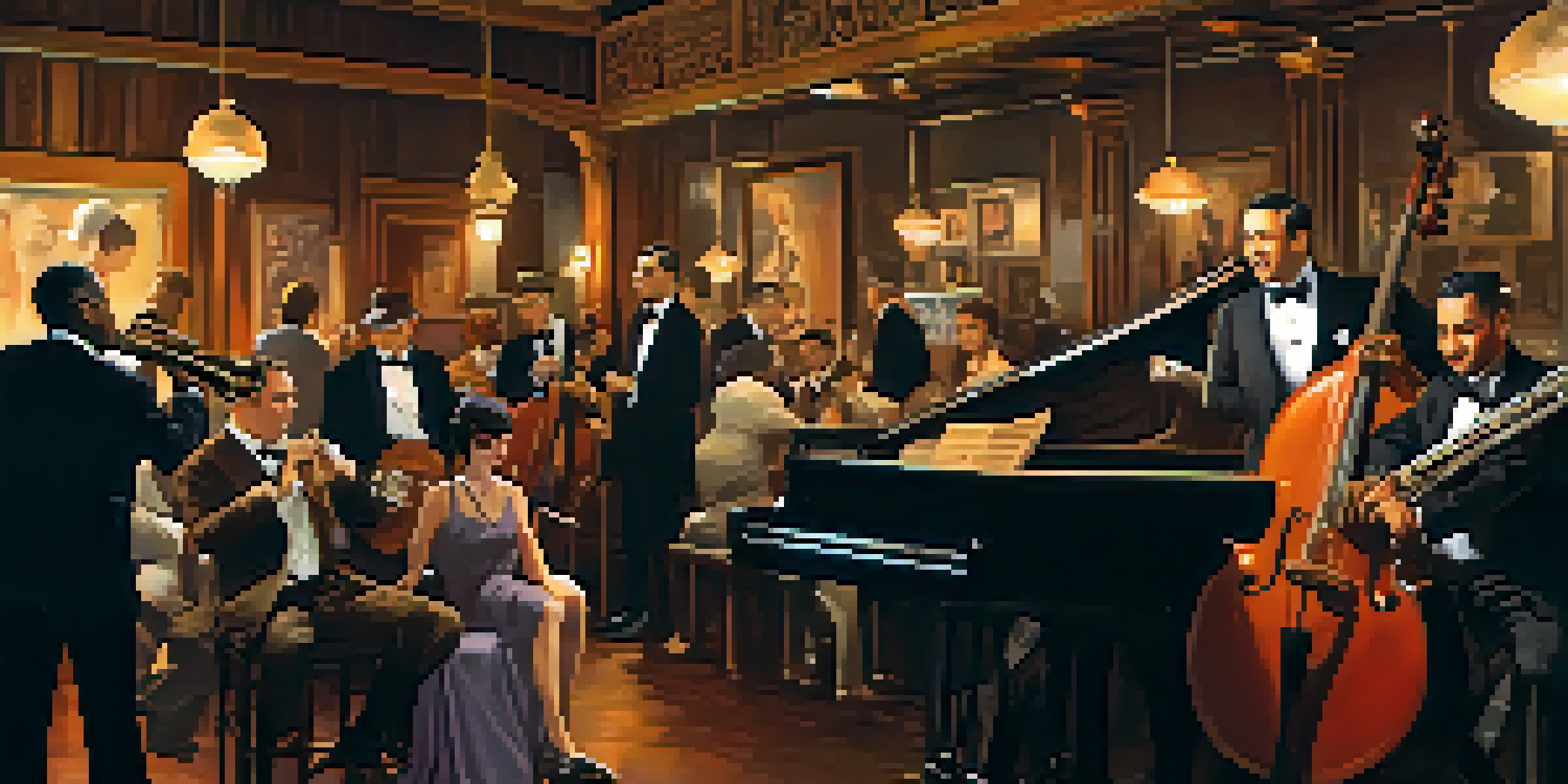The Origins of Kansas City Jazz: A Historical Overview

The Birth of Jazz: A Melting Pot in Kansas City
Kansas City jazz emerged in the early 20th century, blending various musical styles. Its roots can be traced back to the cultural convergence of African American communities, where ragtime, blues, and swing all intersected. This unique fusion created a vibrant sound that was distinctly Kansas City, setting it apart from other jazz styles across the nation.
Jazz is not just music, it's a way of life.
The city’s strategic location as a transportation hub allowed musicians to travel easily and share their sounds. Clubs and dance halls flourished, providing a stage for local talent and drawing in big names from across the country. This rich musical landscape fostered an environment ripe for experimentation and innovation, laying the groundwork for what would become a defining genre.
As the city grew, so did its reputation for jazz. Musicians began to incorporate elements like improvisation and syncopation, which became hallmarks of the Kansas City jazz style. This experimentation reflected the spirit of the city itself—a place where creativity and collaboration thrived.
Key Influences: The Role of African American Culture
The African American community played a pivotal role in shaping Kansas City jazz. This cultural influence brought with it a rich history of music and storytelling, elements that became deeply woven into the fabric of jazz. From the bluesy undertones to the vibrant rhythms, these cultural roots provided a solid foundation for the genre's growth.

Church music also contributed significantly, with spirituals and gospel influencing the emotional depth of jazz performances. Musicians often drew inspiration from these traditions, infusing their work with a sense of soul and urgency. This connection to spiritual music helped elevate jazz to a form of artistic expression that resonated with many.
Kansas City Jazz: A Unique Fusion
Emerging in the early 20th century, Kansas City jazz blended ragtime, blues, and swing, creating a distinct sound that set it apart from other jazz styles.
Moreover, the Great Migration saw many African Americans relocating to cities like Kansas City, bringing diverse musical influences along with them. This influx of talent and styles not only enriched the local music scene but also fostered a sense of community among musicians, creating a supportive environment for new ideas.
The Prohibition Era: A Catalyst for Jazz Growth
The Prohibition era of the 1920s inadvertently fueled the popularity of jazz in Kansas City. As alcohol was banned in public establishments, speakeasies—secret bars that served liquor—began to pop up across the city. These underground venues became hotspots for jazz musicians, providing an ideal setting for their talents to shine.
The great thing about jazz music is that you're not going to get it right the first time.
With the allure of forbidden drinks and lively music, speakeasies attracted diverse crowds eager for entertainment. This environment was conducive to the development of improvisational styles, as musicians sought to captivate audiences with their creativity. The lively atmosphere encouraged spontaneous collaborations, resulting in a vibrant musical scene.
Additionally, the demand for live entertainment during this time helped to elevate jazz musicians to prominence. Artists like Count Basie and Jay McShann began to gain recognition, paving the way for future generations. The jazz culture that thrived during Prohibition would leave a lasting impact on Kansas City's identity.
Influential Figures: Pioneers of Kansas City Jazz
Count Basie is perhaps the most iconic figure associated with Kansas City jazz. His innovative piano style and band leadership brought national attention to the genre. Basie's ability to blend swing rhythms with improvisation set a standard that many would follow, influencing countless musicians both in and out of Kansas City.
Another notable figure was Jay McShann, who played a key role in introducing the Kansas City sound to a broader audience. His band featured young talents like Charlie Parker, who would go on to redefine jazz with his revolutionary bebop style. McShann's contributions helped to solidify Kansas City's reputation as a jazz mecca.
Influential Figures Shaped Jazz
Pioneers like Count Basie and Jay McShann were instrumental in bringing national attention to Kansas City jazz, influencing countless musicians and the genre's evolution.
These pioneers, along with others like Mary Lou Williams and Coleman Hawkins, not only shaped the sound of Kansas City jazz but also inspired future generations. Their legacies continue to resonate, reminding us of the city’s significance in the larger jazz narrative.
The Swing Era: Kansas City as a Jazz Hub
The Swing Era of the 1930s and 1940s marked a golden age for Kansas City jazz, transforming the city into a national hub for the genre. This period saw the rise of big bands and a surge in popularity, with venues like the Reno Club and the Royal Room hosting legendary performances. The energy of the swing music matched the vibrant nightlife of the city, attracting jazz enthusiasts from far and wide.
During this time, the Kansas City sound evolved, characterized by its energetic rhythms and improvisational flair. Bands often featured a front line of horns, with musicians engaging in playful musical dialogues. This lively interaction created an infectious atmosphere that kept audiences dancing and coming back for more.
As jazz spread across the nation, Kansas City remained a vital center for innovation. Musicians from other areas looked to the city for inspiration, further enhancing its reputation. The Swing Era solidified Kansas City’s place in the jazz world, a legacy that continues to influence the genre today.
Legacy and Influence: Kansas City Jazz Today
The legacy of Kansas City jazz is still felt today, influencing countless musicians across various genres. The improvisational techniques and rhythmic styles developed in the city laid the groundwork for modern jazz, and elements of the Kansas City sound can be heard in contemporary music. This enduring impact highlights the city’s role as a breeding ground for creativity and innovation.
Today, Kansas City boasts a vibrant jazz scene, with numerous clubs and festivals celebrating its rich musical heritage. Events like the Kansas City Jazz Festival attract both local and national talent, showcasing the city’s continued importance in the jazz world. The spirit of collaboration and experimentation that defined the early days of Kansas City jazz lives on.
Legacy of Kansas City Jazz Endures
The vibrant jazz scene today continues to reflect the city's rich musical heritage, influencing modern music while nurturing new talent through education and events.
Moreover, educational institutions in the area promote jazz studies, nurturing the next generation of musicians. By providing resources and opportunities for aspiring artists, Kansas City remains committed to preserving its jazz legacy while fostering new talent. This ongoing dedication ensures that the city will continue to be a vital part of the jazz narrative for years to come.
Conclusion: The Enduring Allure of Kansas City Jazz
The story of Kansas City jazz is one of resilience and creativity, rooted in a rich historical context. From its origins as a melting pot of musical styles to its evolution during pivotal eras, the genre has left an indelible mark on the cultural landscape. The city’s unique contributions to jazz continue to inspire and resonate, proving that its influence is far-reaching.
As we reflect on the journey of Kansas City jazz, it’s essential to recognize the musicians and communities that shaped its history. Their passion and dedication paved the way for future generations, ensuring that the spirit of jazz remains alive and well. This enduring allure draws people to Kansas City, eager to experience its vibrant musical heritage firsthand.

In celebrating Kansas City jazz, we also celebrate the power of music to bring people together. Whether through live performances or recordings, the sounds of Kansas City jazz remind us of the joy and connection that music can create, a legacy that will continue to flourish for years to come.